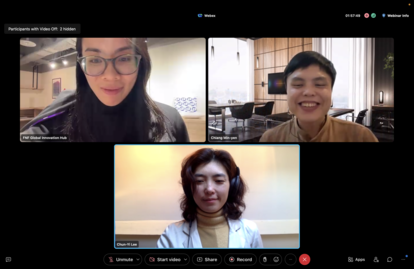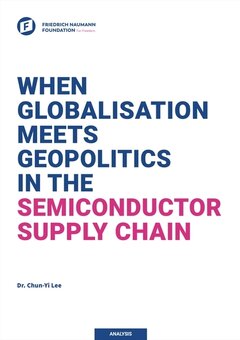Webinar
Decoupling vs. De-Risking: The Interplay of Semiconductor Supply Chains and Geopolitics

On November 30, FNF Global Innovation Hub hosted a publication launch webinar for 'When Globalisation Meets Geopolitics in the Semiconductor Supply Chain.' The webinar featured the publication’s author, Dr. Chun-Yi Lee, an associate professor at the University of Nottingham, and Min-Yen Chiang, a research fellow at the Open Technology Fund, as a co-speaker.
The speakers provided insights regarding the connection between geopolitics and the semiconductor supply chain. They also discussed China's strategies to acquire key semiconductor technologies from Taiwan and how it could bring challenge to the global supply chain. Finally, the speakers exchanged opinions on what like-minded countries should do and offered policy recommendations.
Taiwan As a Highly Desirable Hub
In the first session of the webinar, Dr. Lee emphasized Taiwan's pivotal role in the semiconductor industry, characterizing it as "an important and highly sought-after location." This distinction arises from Taiwan's robust chip production capabilities and the presence of the global industry giant, Taiwan Semiconductor Manufacturing Company Limited (TSMC).
According to Dr. Lee, Taiwan's prominence in the semiconductor sector can be traced back to the 1970s and 1980s when Taiwan's Hsinchu Science Park established "technology bonding" as an innovative means of connection following the breakdown of relations between the US and the Republic of China (ROC) in 1979. During this period, engineers from the US and other overseas locations returned to Taiwan, facilitating knowledge transfer and catalyzing the industry's growth.
Beyond conventional capital and infrastructure, the semiconductor industry places a high value on its workforce, often referred to as "human capital." Dr. Lee's research highlights that this sector thrives in demanding and high-pressure work environments, attracting individuals who are highly disciplined and dedicated to their roles. This workforce dynamic has fostered an ecosystem conducive to success. Notably, Taiwanese companies excel in quality control and disciplined management, areas where Chinese factories are still striving to catch up.
China's Strategies to Acquire Key Semiconductor Technologies from Taiwan
In the second session of the webinar, Min-Yen Chiang discussed China's strategies against the background of US tech sanctions, outlining three models of how China aims to acquire Taiwanese semiconductor technologies and the need for a proactive response.
The first model, the Remote-Poaching model, is exemplified by Bitmain, where an engineering team operates in Taiwan but transfers information back to China. This model involves setting up intermediary companies to recruit Taiwanese engineers and send research and development results to China. It allows China to employ Taiwanese IC design engineers in Taiwan, circumventing current regulatory regimes.
The second model, the Backdoor-Outsourcing model, involves companies like Alchip Tech, which applied for 46 export licenses from the Taiwan government. This model represents the outsourcing of Chinese military-specific chips through standard commercial channels to Taiwanese companies, who oversaw the entire design and manufacturing process, before the finished products were then transported back to China for dual use. It's important to note that this model ultimately ended due to US sanctions.
The third model, known as the Buy-and-Transplant model, was exemplified by Hestia Power. Hestia Power acquired compound semiconductor technologies transferred from the government-backed Industrial Technology Research Institute (ITRI). This acquisition enabled Hestia Power to successfully enter the Chinese electric vehicle market. Technology patents from Hestia Power (Taiwan) were transferred to Hestia Power (Shanghai) without government oversight. The entire Taiwanese R&D team relocated to Shanghai, resulting in the dissolution of Hestia Power (Taiwan).

Collaborative Solutions
On the international front, Chiang suggested that like-minded countries should collaborate to reshape the supply chain and engage in discussions on how Taiwan can access the EU market. This cooperation is essential for successfully navigating the evolving geopolitical landscape.
Chiang discussed China's potential strategy to flood the global market with larger cheaper older technology chips, and stressed the importance of like-minded countries can collaborating on strategies such as, including the implementation of legacy chip taxation.
Chiang also noted that tech sanctions, to some extent, are useful and require further improvement, buying time before China achieves self-sufficient. Chiang believes that even without US sanctions, China remains committed to developing its own supply chain, making it vital to hinder its progress.
Dr. Lee highlighted that completely blocking China's progress might not be viable due to China's unique ideology and territorial ambitions. She proposed maintaining a certain level of China's dependency on Taiwan or the US as a more effective means of controlling China's actions, leading to greater transparency for the international community.
According to Dr. Lee, China also faces domestic challenges, with the "Big Fund" financing its semiconductor sector. She also noted that China's "Pirating" strategy is unsustainable and unable to match the generations of hard work in Taiwan's semiconductor industry.
In summary, both speakers noted that the US-China rivalry in the tech sector represents a unique challenge, distinct from the Cold War era, as China is deeply integrated into the global network. Navigating this complex landscape requires adaptive strategies and international cooperation to ensure the stability of semiconductor supply chains amidst shifting geopolitical tides.

